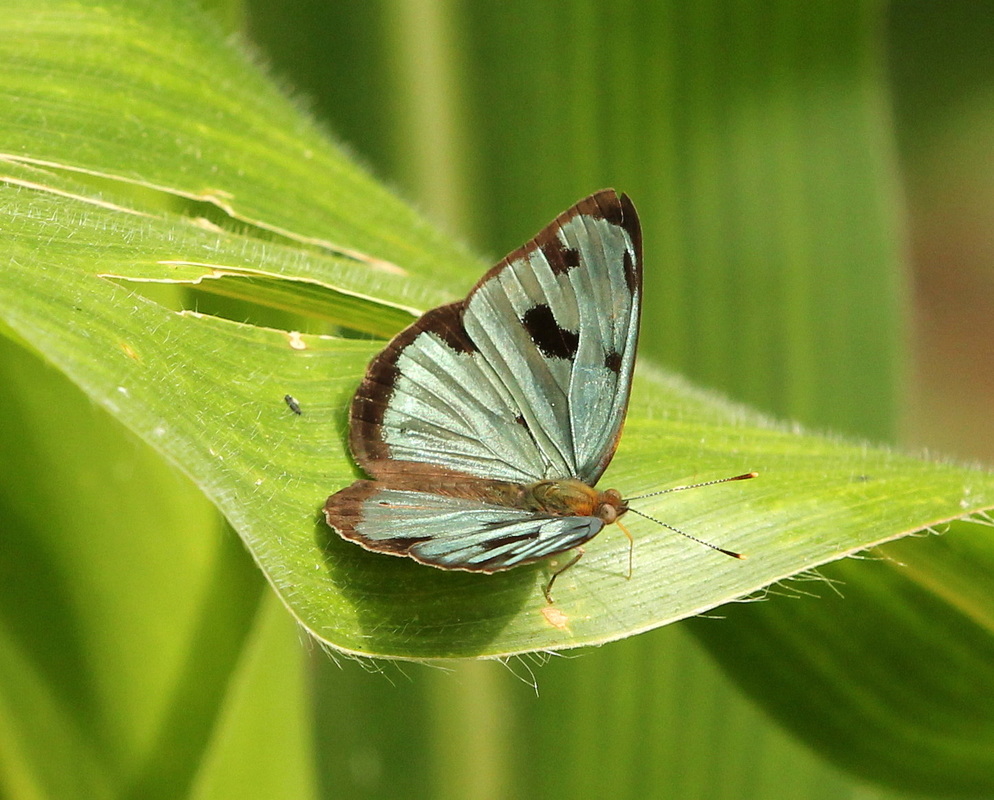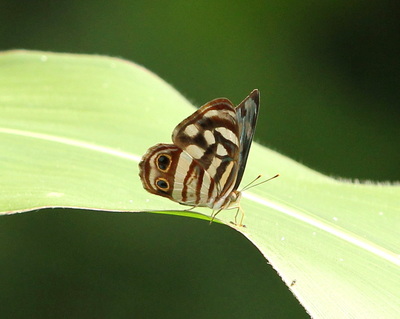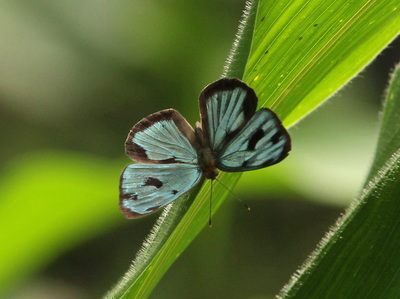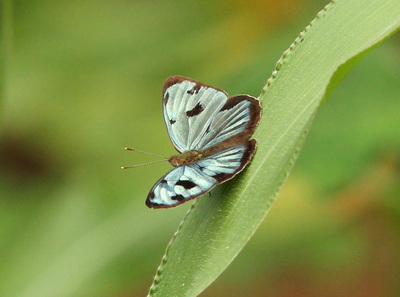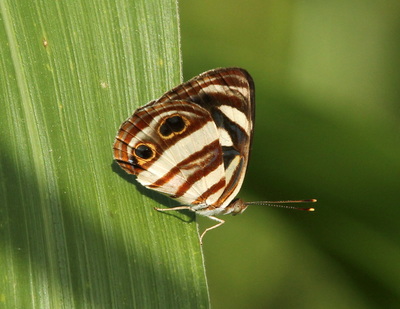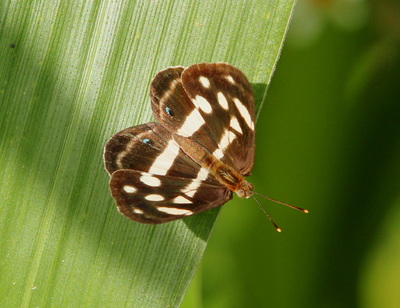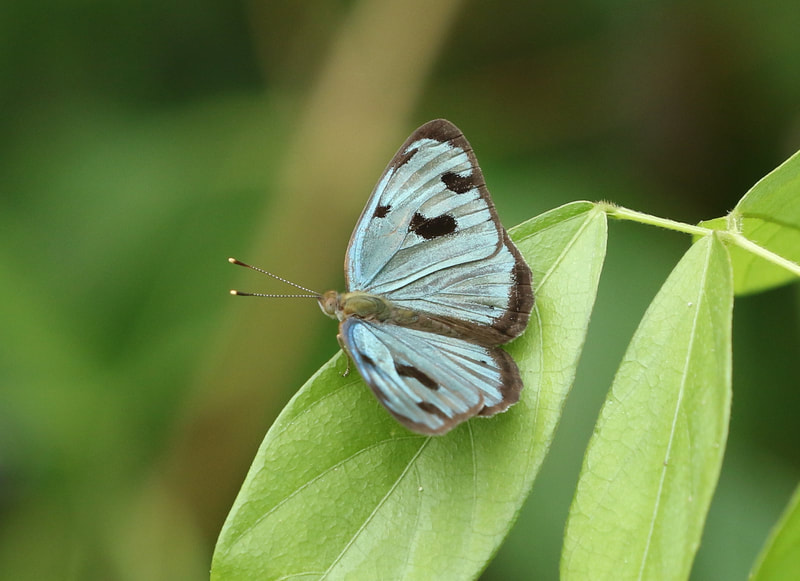Nymphalidae : Biblidinae
Dynamine postverta d'Almeida, 1952
Mexican Sailor
Dynamine postverta d'Almeida, 1952
Mexican Sailor
Description and Similar Species: Wingspan 40-44mm. Sexually dimorphic with males being largely metallic blue above and females being brown and white. The very similar Caribbean Sailor Dynamine serina is pale green rather than blue above in males, while females have blue bases to the wings. The undersides are very similar but the anterior eyespot on the hindwing is oval not round in shape. If only the underside is seen then Caribbean Banner Lucinia sida also needs to be ruled out but this species is orange above so there can be no confusion if seen in flight. Like D. serina in sunshine it often sits with wings half open
Range: From Central America to Argentina. In the West Indies it is found on Cuba and, following a period of rapid eastern expansion on Cuba it was found in the Dominican Republic in December 2019 for the first time. Strays have been seen in southern Texas.
Status: In Cuba it used to be known only from the west of the island where the population is thought to be supplemented by immigration from the west (presumably Mexico). It has been reported from Pinar del Rio in the far west for at least 140 years occasionally dispersing east into Habana province and then apparently receding and even dying out but reappearing sporadically, at times in abundance, on the Guanahacabibes peninsula (Smith, Miller & Miller). So it was a big surprise to Douglas Fernández when on 3 December 2015 he saw one at Sierra Cubitas, Camagüey province in the centre of the island. Eleven months later on 27 September 2016 we saw another at exactly the same location so it appears established there. When visiting the Alejandro de Humboldt NP near Baracoa, Guantanamo Province a few months earlier, in June 2016, I watched a male briefly settle on a tree in front of us - this is several hundred km further east from Camagüey province and only 40km from the eastern tip of Cuba. In September and early October 2016 we saw both males and females near Guardalavaca, Holguin Province. We watched up to seven at a time in several locations both around the hotel grounds and further inland indicating that it has now spread right to the east of the island. Between 2016 and 2019 it has been seen in increasing numbers eg in April 2018 it was first seen at GTMO by Wayne Fidler, and in Nov/Dec 2018 we saw it on nine out of 20 days of our holiday between Guardalavaca and Moa. The eastwards expansion has continued and on 1 December 2019 it was recorded for the first time in the Dominican Republic near Altamira, Puerto Plata by Lisa McDowell Johnson.
Nectar Plants: Flowers of various Asteraceae. It also takes moisture from leaves and also on damp ground.
Larval Foodplants: Unknown but on the mainland the hostplants are Dalechampia sp and Tragia sp. Smith (1994) states that the larval foodplant is probably Platygyna hexandra.
Range: From Central America to Argentina. In the West Indies it is found on Cuba and, following a period of rapid eastern expansion on Cuba it was found in the Dominican Republic in December 2019 for the first time. Strays have been seen in southern Texas.
Status: In Cuba it used to be known only from the west of the island where the population is thought to be supplemented by immigration from the west (presumably Mexico). It has been reported from Pinar del Rio in the far west for at least 140 years occasionally dispersing east into Habana province and then apparently receding and even dying out but reappearing sporadically, at times in abundance, on the Guanahacabibes peninsula (Smith, Miller & Miller). So it was a big surprise to Douglas Fernández when on 3 December 2015 he saw one at Sierra Cubitas, Camagüey province in the centre of the island. Eleven months later on 27 September 2016 we saw another at exactly the same location so it appears established there. When visiting the Alejandro de Humboldt NP near Baracoa, Guantanamo Province a few months earlier, in June 2016, I watched a male briefly settle on a tree in front of us - this is several hundred km further east from Camagüey province and only 40km from the eastern tip of Cuba. In September and early October 2016 we saw both males and females near Guardalavaca, Holguin Province. We watched up to seven at a time in several locations both around the hotel grounds and further inland indicating that it has now spread right to the east of the island. Between 2016 and 2019 it has been seen in increasing numbers eg in April 2018 it was first seen at GTMO by Wayne Fidler, and in Nov/Dec 2018 we saw it on nine out of 20 days of our holiday between Guardalavaca and Moa. The eastwards expansion has continued and on 1 December 2019 it was recorded for the first time in the Dominican Republic near Altamira, Puerto Plata by Lisa McDowell Johnson.
Nectar Plants: Flowers of various Asteraceae. It also takes moisture from leaves and also on damp ground.
Larval Foodplants: Unknown but on the mainland the hostplants are Dalechampia sp and Tragia sp. Smith (1994) states that the larval foodplant is probably Platygyna hexandra.
